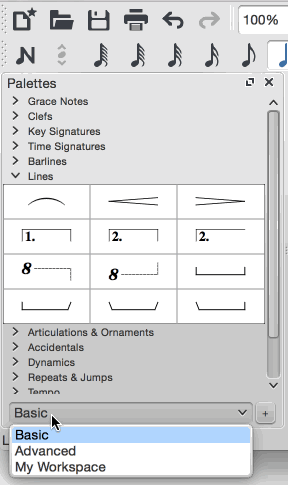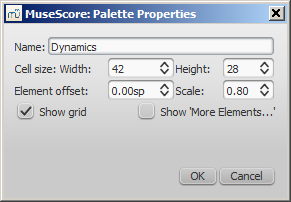Palettes and workspaces
To the left of the document window is the Workspace. This can be toggled on and off using the menu command, View → Palettes, or the shortcut, F9.
A workspace, in turn, consists of a number of palettes. Each palette is a folder containing a group of musical symbols.
Workspaces
MuseScore provides two preset workspaces: Basic (the default option) and Advanced (a version with more palettes and symbols). These contain symbols drawn from the various sections of the Master palette. In addition, you can create your own custom workspaces (below).
- To switch between workspaces: Use the drop-down menu at the bottom of the workspace panel.

The names of palettes within a workspace are listed under the title "Palettes."
Single Palette Mode
If you only want to allow one palette to open at a time, right click at the top of the workspace and check the "Single palette" box. This will cause a palette to automatically close when you open a different one.
Docking/undocking
To dock or undock a workspace, see Side panels.
Custom workspace
A custom workspace allows you to select which palettes are listed, and to customize the contents of those palettes.
To create a customizable workspace:
- Select an existing workspace. Use the drop-down list at the bottom of the workspace panel if needed.
- Click the + button, enter a name for the new workspace and press OK. The new workspace is added to the panel.
Alternatively you can use the menu option:
- Select Edit → Workspaces, and chose a workspace.
- Select New. Fill in the new workspace name and click OK.
Right-clicking over the workspace will display a menu: this has options allowing you to insert, delete, rename and reorder the palettes within it. The contents of individual palettes can be edited in a similar fashion once you've checked "Enable Editing" for a palette. For more details, see Custom palettes and Palette menu (below).
Palettes
Open/close palette
- Click once on the name of the palette or its accompanying side-arrow.
Apply symbols from a palette
A palette symbol may be applied to the score using one of the following methods:
- Select one or more score elements and double click the palette symbol.
- Drag and drop the symbol onto the desired score element in the staff.
Tip: To prevent accidental rearrangement of contents during use, right-click over a palette name and untick "Enable Editing."
For example, to add tenuto marks (—) to a selection of notes:
- Select the desired notes.
- In the Articulations & Ornaments palette, double-click on the tenuto symbol
Once added to the score, objects can be copied, pasted, and duplicated—see Copy and paste.
Preset palettes (Advanced workspace)
The more fully-featured Advanced workspace contains the following palettes:
- Grace Notes
- Clefs
- Key Signatures
- Time Signatures
- Barlines
- Lines
- Arpeggios and Glissandi
- Breaths and pauses
- Brackets
- Articulations and Ornaments
- Accidentals
- Dynamics
- Fingering
- Note Heads
- Tremolo
- Repeats and Jumps
- Tempo
- Text
- Breaks and Spacers
- Bagpipe Embellishments
- Beam Properties
- Frames and Measures
- Fretboard Diagrams
Custom palettes
Once you have created a custom workspace (see above), and enabled editing (see Palette menu below), you can customize the palettes within it to your own requirements.
To add an existing score element (such as a line, text, dynamic, fretboard diagram etc.) to a custom palette:
- Press and hold Ctrl+Shift (Mac: Cmd+Shift), then drag the symbol onto the palette.
To add a symbol to a custom workspace from the Master palette:
- Drag the symbol from the Master Palette window into a custom palette.
To re-arrange a symbol in a custom palette:
- Drag the symbol to the cell you want it to display in: it will swap places with the symbol currently occupying that cell.
Palette menu
Right-clicking on the name of a palette in a custom workspace brings up this menu:
-
Palette Properties...: Adjust the appearance of the open palette:

- Name
- Cell Size: Width, Height
- Element Offset: Adjust the vertical offset of all elements in the palette.
- Scale: Make all palette elements appear larger or smaller.
- Show grid: Visually divide the palette into cells, one for each element.
- Show ‘More Elements…’: Create a cell which opens the Master Palette.
- Insert New Palette: Create a new empty palette.
- Move Palette Up / Move Palette Down: Reorder the palettes.
- Enable Editing: Allow modifying the contents of the palette.
- Save Palette: Save as an .mpal file.
- Load Palette: Load an .mpal file.
- Delete Palette: Remove the palette from the workspace entirely.
Right-clicking on an element within a palette (if editing of the palette is enabled) brings up this menu:
- Clear: Remove the element from the palette
- Properties...: Open the Palette Cell Properties dialogue:
- Name: The tooltip that appears when you mouse over the element.
- Content offset (X, Y): Adjust the position of the element in the palette.
- Content scale: Make the element appear larger or smaller in the palette.
- Draw staff: Draw the five lines of a musical staff behind the palette element.
- More Elements: Open the relevant Master Palette section.
Note: Changing values in "Palette Cell Properties" only affects the appearance of elements in the palette. It does not change their sizes or offsets on the score page.
Behavior of applied text and lines
If the symbol you are adding to the score from a palette contains a text element (e.g. staff text, dynamic, fingering, volta etc.), then properties such as font-type, font-size, text color, and alignment will adapt according to the following rules:
-
Text properties which have not been altered by the user will adopt the relevant, prevailing text styles.
-
Custom text-properties—i.e. those changed by the user before saving the symbol to a custom palette—remain as customized.
By contrast, the line properties of lines applied from a palette always remain unchanged (i.e. as set by the user before saving to a custom workspace, or as predefined in the Basic/Advanced workspaces).